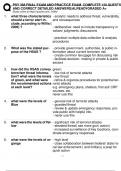PSY 368 FINAL EXAM AND PRACTICE EXAM COMPLETE 120 QUESTIO
AND CORRECT DETAILED ANSWERS|ALREADYGRADED A+
Study online at https://quizlet.com/_fv99zl
1. what three characteristics - analytic: needs to address threat, vulnerability,
should a terror alert in- and consequences
clude, according to Willis (
2006) ? - deliberative: need to include transparency in
values/ judgments. discussions
- practical: multiple data collection & analysis
procedures
2. What was the stated pur- - provide government, authorities, & public in-
pose of the HSAS ? formation about current terrorism risk
- create common lanugage for discussing risk
- facilitate decision- making in private & public
sectors
3. how did the HSAS convey green:
terrorism threat informa- - low risk of terrorist attacks
tion? what were the levels - low threat
of green, and what were - refine & organize procedures for potential ter-
the recommended actions rorist attacks
at each level? e.g. emergency plans, shelters, first aid/ CRP
courses, etc.
never use this
4. what were the levels of - general risk of terrorist attacks
Blue - guarded threat
- review & update emergency responses, pro-
vide public with helpful info.
- never use this
5. what were the levels of Yel- - significant risk of terrorist attacks
low - elevated threat( see more govt. action)
- increased surveillance of key locations, coor-
dinate emergency responses
6. what were the levels of or- - high level
gange - close collaboration between federal/ state/ lo-
cal law enforcement ( and military) a prep for
quick action
, PSY 368 FINAL EXAM AND PRACTICE EXAM COMPLETE 120 QUESTIO
AND CORRECT DETAILED ANSWERS|ALREADYGRADED A+
Study online at https://quizlet.com/_fv99zl
- extra caution at public events, consider alter-
natives
- travel warnings ( delays & restrictions)
- spent a lot of time at this level
7. what were the levels of red - severe level
- emergency personnel dispatched to key loca-
tions, monitoring of transportation readiness to
close down public/ govt. facilities
8. what are the advantages of - well-intentioned ( warn the unsuspecting)
the HSAS - simple to understand
9. what were the disadvan- - yellow to orange -> increased physiological
tages of the HSAS arousal, anxiety, depression
- mentally ill, disabled, african Americans, lati-
no, Chinese americans, Korean Americans,
non-US citizen all perceived higher risk levels
than white, healthy controls
- overstimulated threat-> stronger physiologi-
cal/ psychosocial reactions -> avoidance be-
haviors
- chronic fear & anxiety -> more chronic med-
icate conditions, cardiac events, more sub-
stance abuse
- lots of negative health outcomes, especially
for some population
10. what is an National Ter- communicate gender terrorism-related info
rorism Advisory System ( a. not necessarily a direct threat to US, but info
NTAS) bulletin that may be helpful to law enforcement, etc
11. What is an NTAS alert ? - specific, creditable information about a terror-
ist threat against the US
- info about threat, targeted geographic region,
mode of transportation, infrastructure potential-
ly affected, etc
- steps for individuals and communities to pro-
, PSY 368 FINAL EXAM AND PRACTICE EXAM COMPLETE 120 QUESTIO
AND CORRECT DETAILED ANSWERS|ALREADYGRADED A+
Study online at https://quizlet.com/_fv99zl
tect themselves, prevent/ mitigate/ respond to
threat
12. what is the difference be- elevated alert: credible threat, but only general
tween an elevated alert info. about timing, target, etc.
and an imminent alert?
imminent alert: credible, specific threat info. and
believed to be impending
13. How do fear and anger dif- fear: appraisals of uncertainty, situational con-
fer when it comes to risk trol ( negative)
appraisal?
anger: appraisals of certainty, individual control
( positive)
14. What do these different ef- - anger= most dominant emotion
fects on risk appraisal pre- - men more optimistic than women
dict about people's coun-
terterrorism preferences? - anger -> lower risk estimate-> fewer plans
for responding to future attacks ( more support
for vengeful deportation policy, less support for
conciliatory policy
- fear-> higher risk estimate- more plans for
responding to future attacks ( less support for
vengeful deportation policy, more support for
conciliatory policy)
- anger triggered optimism, while fear triggered
pessimism
15. How do the psychologi- threat:
cal effects of perceived - vilify threatening out-group ( threats-> in-
threat differ from the psy- creased authoritarianism -> increased preju-
chological effects of anxi- dice and intolerance & ethnocentrism
ety ?(Huddy et al ( 2005) ) - support for punitive action against out-group
threat - increased in-group solidarity
16.




